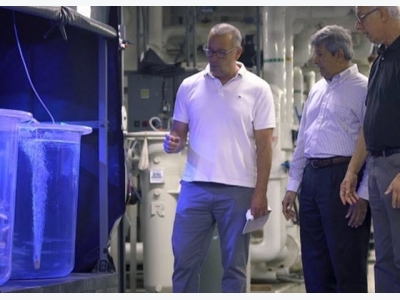Startups first product a potential game changer

Aquaculture's big problem has not been the absence of effective vaccines, rather, it is in the way those vaccines are delivered, says CEO Dr Ken Malone (at left), shown with Dr Vik Vakharia (center) and a colleague
A Baltimore, Maryland startup has come up with a novel way of battling Viral Nervous Necrosis (VNN), a disease that affects over 40 aquaculture species worldwide.
Dr Ken Malone, CEO of startup VakSea Inc, says the aquaculture industry’s big problem has not been the absence of effective vaccine, rather, it is in the way those vaccines are delivered.
“Current methods of delivering vaccines to fish involves injecting fish with vaccine one by one, which is expensive, labor intensive, and stressful to the fish,” says Malone.
VakSea grows the vaccine inside insect larvae, grinds up the larvae, mixes it into fish feed, then feeds it directly to the fish. When the fish eat the feed, they become immune to the disease.
The startup’s proprietary vaccine technology was developed at the University of Maryland Baltimore County (UMBC) in the lab of Dr Vik Vakharia beginning in 2014. VakSea filed a provisional patent application in 2016. It is now developing a pellet-based vaccine aimed at protecting European seabass juveniles from VNN and hopes to get it to market over the next 12 to 18 months.
VNN “damages the central nervous system in susceptible fish species and typically affect younger stages of fish (larvae, fry, fingerlings), although older, market-size fish can be affected as well, with losses ranging from 15–100 percent,” according to University of Florida-IFAS Extension researcher Roy P. E. Yanong, in his paper Viral Nervous Necrosis (Betanodavirus) Infections in Fish.
“Infected larvae and juvenile stages often show abnormal swimming behavior, including vertical positioning and spinning; flexing of the body,” he wrote.
Species susceptible to VNN include red drum, cobia, sea bass, barramundi, gilthead seabream, Pacific bluefin tuna, various grouper species, various flatfish species including halibut and Japanese flounder, as well as tilapia.
Malone is confident of the potential of Vaksea’s proprietary vaccine technology with other species. “We’ve proven it out on the nervous necrosis virus and we know it’s going to work on a large number of species and a large number of other diseases,” he says.
Related news
 U.S. to make decision on fish imports from Vietnam in March
U.S. to make decision on fish imports from Vietnam in March A U.S. decision may be made in late March on whether the world’s biggest economy will continue importing tra fish (pangasius) from Vietnam
 Tra Vinh: seafood exports expected to reach 352 mln USD in 2018
Tra Vinh: seafood exports expected to reach 352 mln USD in 2018 The Mekong Delta province of Tra Vinh hopes to earn about 8 trillion VND (352 million USD) from exporting seafood in 2018.
 Tra fish prices at highest level in last 20 years
Tra fish prices at highest level in last 20 years The price of tra fish in the Cửu Long (Mekong) Delta has risen to its highest price over the last 20 years, leading to high profits for local farmers.